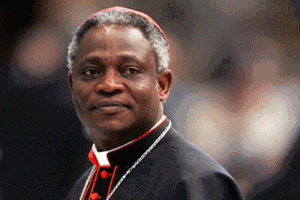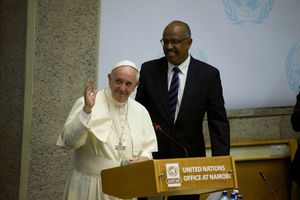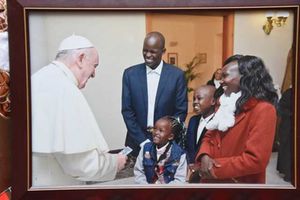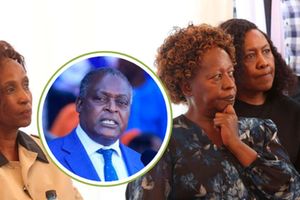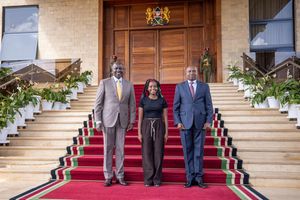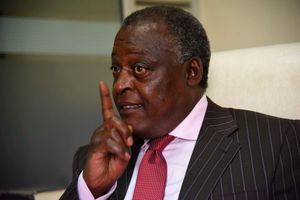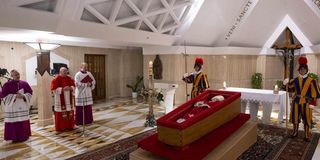
Pope Francis's body lies in state at the chapel of Santa Martha at Vatican City.
A thin, red book written in 1998 and revised in 2024 is controlling the events happening in the Vatican after Monday’s death of Pope Francis, governing most of the proceedings.
Titled Ordo Exsequiarum Romani Pontificis (Rite of Burial for Roman Pontiffs), its provisions were followed to the letter on Wednesday as Pope Francis’ body was carried to St Peter’s Basilica and placed for public viewing — an event called translation of the body.
According to the pontiff’s media service, “over 20,000 people had gathered in the square to pay their respect to the late Pope, erupting into subdued but sustained applause as his coffin was carried up the steps and into St Peter’s Basilica”.
The huge crowds have created a need for heightened security, and the BBC reported increased barricades and checks by police on people entering St Peter’s Square. Some security officers there were also seen with anti-drone gadgets.
The Wednesday viewing of the body lying in state was scheduled to happen from 11 am to midnight local time. This, according to the book, has to happen when the Pope’s coffin is open.
On Thursday, the viewing will begin at 7 am local time to midnight.
On Friday, it will start at 7 am and end at 7 pm.
At 8 pm on Friday, a ceremony will be held to close the coffin. The event will be led by Cardinal Kevin Farrell, who is the carmelengo (the person who runs the Vatican after the death or resignation of a Pope).
One of the actions to be taken before the coffin is sealed will be placing Vatican coins minted during Pope Francis’ tenure in it. The BBC, quoting the Pope’s biographer, reported that a coin is produced for each year of the Pope’s tenure, meaning 12 coins placed in a bag will be slotted into Francis’ coffin.
Also to be placed in the coffin will be a one-page account of the pontiff’s reign that will be encased in a tube.
That ceremony, again, is provided for in that red book. It was first written by Pope John Paul II, and it guided his burial and that of Pope Benedict XVI. Did you notice the red colour in the vestments the Pope’s body was dressed in? That colour is defined thereon. Noticed the mitre on his head? The book says it must be there, same as the candle next to the coffin.
Pope Francis ordered a revision of the book last year to simplify some of the procedures, according to the Associated Press. Some of the changes he introduced include the removal of the scenes where the Pope’s body could be displayed outside the coffin. It also stipulated that papal burials must not always take place at St Peter’s Basilica.
As the viewing went on, Nation.Africa on Wednesday reached out to the East African leader of the Jesuits order of the Roman Catholic Church.
Despite their claim that they are the largest Catholic religious order in the world, the Jesuits have never produced a pontiff until Pope Francis in 2013.
Even as their different alignments may not be obvious to the casual observer, Catholic ministers (bishops, priests, brothers, nuns, among others) usually belong to a particular order. Besides Jesuits, the other orders include Benedictines, Dominicans, Franciscans, Carmelites and Paulists.
In Kenya, the Jesuits run the St Joseph the Worker Parish in Kangemi (one of the places Pope Francis visited in his 2015 tour of Kenya) plus Christ the King Parish in Kangemi. They also run the St Charles Lwanga parish in Malindi.
Jesuits' pinnacle
The Jesuits, also known as the Society of Jesus, also run the Loyola Centre for Media and Communication, housed in Nairobi’s Kilimani, and run a significant portion of the Kakuma Refugee Camp.
Equally, they run the Hekima University College along Ngong Road, among other projects.
Having never produced a Pope before, the local Jesuits were elated with Pope Francis’ ascendancy to the pinnacle of the church.
Fr Dr Kizito Kiyimba, the provincial superior of the Jesuit province of Eastern Africa, said they were “a bit surprised” when Pope Francis was elected in March 2013.
Fr Kiyimba heads the East Africa province that entails Kenya, Uganda, Tanzania, South Sudan, Ethiopia and Sudan.
“It’s very rare to find a Jesuit bishop, let alone a cardinal,” he said.
He noted that it was Pope Francis’ habit to see Jesuits in whatever place he visited.
“[He would] sit down with them and talk Jesuit stuff,” he said.
“Remember, he went to St Joseph’s Kangemi, which is a Jesuit parish. Then he was in South Sudan and there we sat with him for one hour in Juba. Jesuits gathered around him. So, he had that brotherly connection. He never forgot his Jesuit roots. He made us feel at home around him. He remained simple and accessible. Even when he challenged us to live by example, he was fatherly. He was very pastoral in his approach,” said Fr Kiyimba.
Some of the tenets of the Jesuit order that Pope Francis stuck to, he said, include speaking truth to power “without becoming antagonistic”.
“We try our best to step in for justice and peace. And whenever possible, we try not to antagonise. We do it in the service of the little people; the small people who have forgotten or downtrodden. It’s not for self-aggrandisement, and that’s what Pope Francis represented,” said Fr Kiyimba.
Another tenet the pontiff never wavered from, Fr Kiyimba noted, was that of minding the forsaken.
“He emphasised accompaniment on a global scale; so he supported refugees, the poor, the marginalised, the forgotten, which are things that Jesuits do,” he noted.
Fr Kiyimba was quick to note that even with the various orders of the Roman Catholic Church, they are under one umbrella.
“They are all in the service of obedience to the Pope, but each of them represents a different aspect of God. The aspects are called charisms. Some of them, like the Franciscans, will bring out the charism of God reaching out to the poor. So you will see them dressed very poorly. They wear sandals and so on.
"They live a very, very frugal life because they remind us that Jesus was poor. Then you find some that engage the world on its terms. Those are, for example, the Jesuits. That’s a different charism. We find God in everything. That’s our charism,” he said.
“Then you find the Dominicans. It’s called the Order of Preachers. For them, they bring out the word; that the word of God has to be understood and inserted in current society, in contemporary society. So, they are formed to preach the word in relevant ways,” he went on. “We are not sects; we are all Roman Catholics. But we try to represent how infinitely varied the aspects of God are.”
Fr Kiyimba, who hails from Uganda, noted that the Jesuits are pleased with Pope Francis’ achievements.
“We are really proud that he did a good job by our own standards, but also from what we hear from other people around the world: not only Catholics, not only Christians, not only believers. The world around thinks Pope Francis has been a good moral leader in an increasingly belligerent, greedy, divisive world. He was a moral voice. So, we are proud, and we hope that the next Pope will continue to lead the church where God wants it to go.”
Meanwhile, various media outlets continued to explore Pope Francis’ story. National Geographic attempted to paint a picture of a typical day in the Pope’s life, revealing that he preferred to manage his schedule personally.
"Modest accommodation"
It stated that his day would start “in his modest accommodation at Casa Santa Marta, the Vatican guest house” with prayer and meditation before he preached at a morning Mass.
After lunch, it wrote, the Pope typically had a siesta.
“His afternoons were often spent visiting prisons and juvenile detention centres, consulting with ambassadors to the papacy, or making appointments. Once a week he received a soccer update from a member of the Swiss Guard [his security detail], a necessity since the pope stopped watching television in 1990. Though Pope Francis may have given up television, he was an active lover of the arts,” added National Geographic.
Also, Nation.Africa conducted an online search of people who named their children after Pope Francis, with interesting results.
One Frank Lomocso posted on Facebook on Tuesday: “We prayed for a baby boy; we asked for intercession with Our Lady of Guadalupe. When Pope Francis visited UAE [United Arab Emirates] in 2019, being one of the crowd at his papal Mass felt like Pope Francis brought the good news by saying our prayer had been answered. Nine months and two weeks after Pope Francis visited the UAE, our son was born.”
Arkangelo Victor also wrote on Tuesday: “My son Francis was named after the Holy Father, Pope Francis. He was born on the day of the papal Mass in South Sudan. I felt truly blessed, and both my wife and I decided to name our son Francis.”
On Wednesday, the Vatican website released a notification for the interment of the pontiff’s coffin this weekend.
“On Saturday, April 26, 2025, at the end of the funeral Mass, the coffin of the Roman Pontiff Francis will be accompanied to the Papal Basilica of Santa Maria Maggiore for burial,” it read in part.

